While cycle lanes and paths are all very nice, there are still many situations where it is not feasible or sensible to install them. For example, there may be limited road width to play with (and no politically easy way to give up some space from other things like parking). Or the cycling route may be on a very quiet street where it makes no sense to install special separate facilities. In these cases, how do you let road users know to expect to see people cycling?
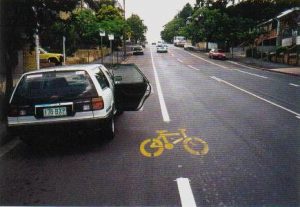
You can’t just use a standard white cycle symbol because in NZ it legally indicates a cycle lane and all that entails (e.g. other traffic can’t drive along a cycle lane or park in it). Enter the “sharrow” (or “shared arrow”): Originally developed in North America, it’s a form of “advisory cycle marking”, whereby it doesn’t actually connote any legal obligations like a cycle lane. Instead it just indicates to everyone that you might expect to see people on bikes here and they might be sharing your traffic lane (rather than hugging the kerb).
There have been a few variations on a theme over the years. In Queensland for example, they used to use a yellow cycle symbol for a “bicycle awareness zone”, to indicate various situations where a bike would be somewhere in the vicinity of the traffic lanes (think: outside parked cars, approaching a narrow roundabout, on the inside of a blind curve, etc).
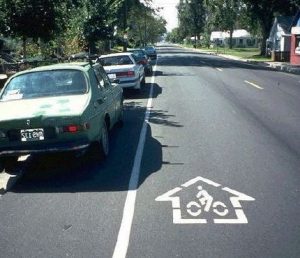
Or in San Francisco they experimented with a “bike in an arrow” symbol, again trying to position passing bikes in a safe location away from car doors (which, as we’ve mentioned before, can be a big menace when cycling).
More recently, the most popular advisory symbol to use is the sharrow, essentially a bike symbol with two chevron arrows on top of it. Like the others, as well as providing a visual reminder to all road users, it also indicates where a bike rider should position themselves laterally on the road.

It wasn’t long before some keen bods in NZ saw these and wanted to use them in their fair towns. However, being a stickler for due process, NZ Transport Agency and the Road Controlling Authorities Forum have formed a working group to undertake proper trials of these markings at various locations around the country before ratifying them officially. Auckland in particular have been rather keen, and a number of locations are about to get rolled out up there. The surveys will monitor things like motor vehicle speeds, lateral position of bikes and motor vehicles, and perceptions/understanding of the general public.
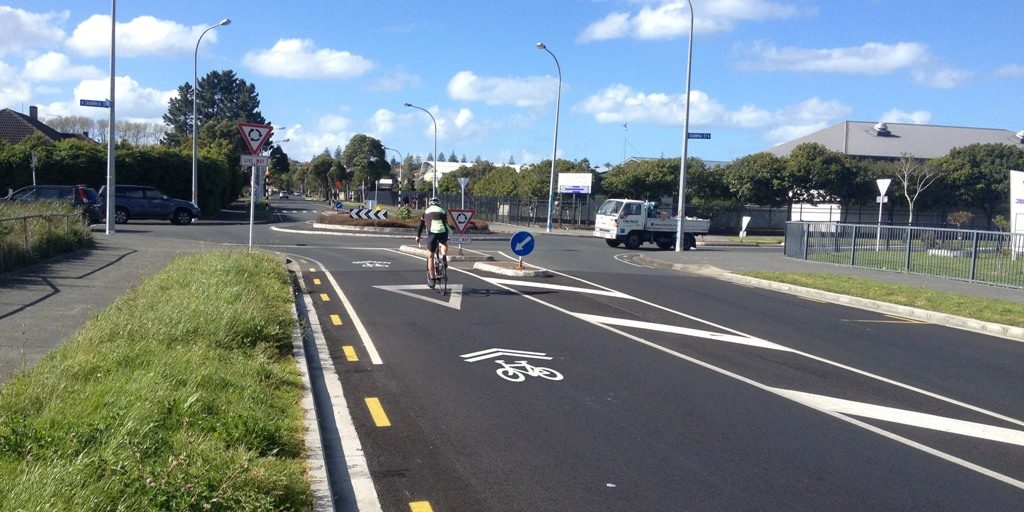
Christchurch City is on the working group and has been considering whether to try these out here as well. They could be used in a number of situations:
- Along neighbourhood greenway (or “quiet street”) routes as part of the Major Cycleways
- For isolated treatment of known pinchpoints where riders have to get over into the traffic lane (e.g. near parking).
- On approaches to single-lane roundabouts or narrow bridges, where taking the lane is appropriate
- On deliberately narrowed streets, perhaps as part of shared spaces
- On the inside of blind curves to warn of the possible presence of riders in front
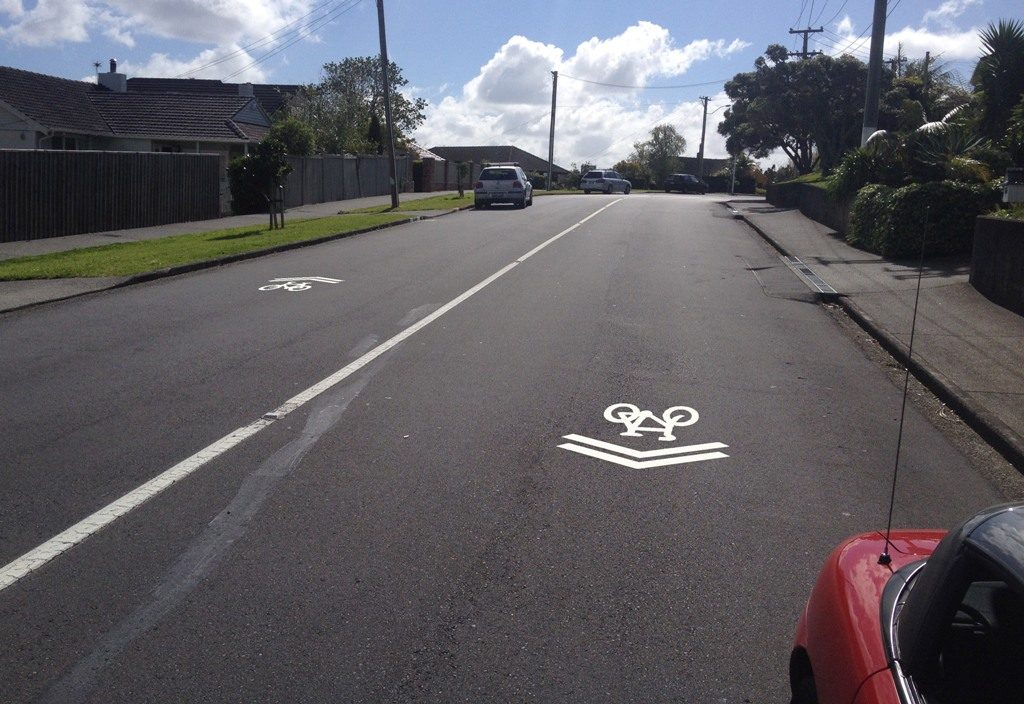
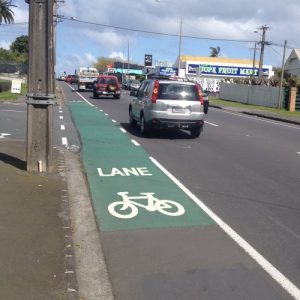
Interestingly, one of the side effects of introducing a new cycle marking is that we may have to tweak the existing cycle lane markings to make it clear what they legally are. This could be done for example by adding the word “LANE” to the cycle symbols.
Sharrows are not a solution for everywhere, and they’re certainly not just a cheaper substitute for proper cycle lanes/paths. The most appropriate locations for them are on streets with low traffic volumes and/or speeds, where bikes can safely “take the lane” as indicated. And they have to be carefully located to ensure that riders are clear of the “door zone” of any parked vehicles. But they could be another useful tool in our cycling toolkit.
What do you think of sharrows? Where can you think they could be used in Chch?

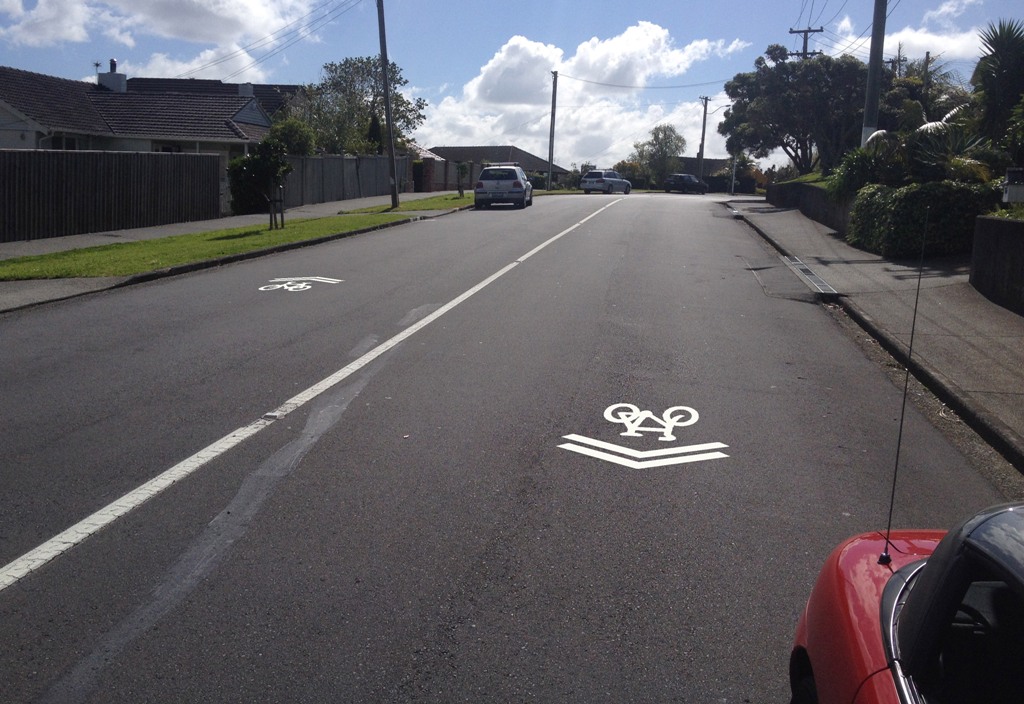
I loke the Idea. It is a pity that NZTA are very slow in taking up any idea which may improve road safety for all users. I have suggested to them an area on highway 6 where there is 3m of sealed road to the left of the fog line, but they had so many reasons why it cant be done. however with the ‘Sharrows’ perhaps it may be a suitable option.
Anther idea about cycle safety comes from the UK where there are parking restrictions around 7.30 am till 9 am and likewise 4pm till 5.30pm. it would make cycling safety in Chch a lot safer
I’ve experienced the selfishness of a small minority of drivers who believe that no matter how narrow a road, that they should always have priority. Slowing down behind a cycle for less than ten seconds, even when traffic is queuing anyway, is somehow seen as an infringement of their ‘rights’ as a car driver.
CCC informed me that placing a ‘share the road’ sign was not possible on 50kmh roads in the city.
So, having action for a symbol that makes drivers think twice about being considerate and respectful is welcome. However, ought to be used with care, so that it doesn’t end up being used instead of careful road design or becomes oblivious due to over use.
I like the sharrows, and wish that the word ‘lane’ could be applied to cycle lanes too as depicted.
The sharrows remind me of a computer game which accelerate the player when it is overlapped.
There is a lack of thought behind the clause "The most appropriate locations for them are on streets with low traffic volumes and/or speeds, where bikes can safely “take the lane” as indicated. " The road code requires a cyclist to "take the lane in any place where "the road is too narrow to safely allow vehicles to pass, you are in danger of being run off the road or hit by a passing car".
Some roads are therefore not considered safe enough for a Sharrow Symbol, despite the fact that cyclists will need to share the road with motor vehicles, and will need to take the lane anyway. In my opinion, these are the roads where the Sharrow symbol will do the most good, by making clear that the lane is shared (despite whether some unspecified person thinks it is ‘Safe" or not.
There’s some places that would benefit from these, and some that don’t.
Colombo Street between Hereford and the airbridge, does NOT benefit from sharrows – the road seems deliberately too narrow for cars and bikes and parking, and there is insufficient room for bikes to filter, so you’re stuck in-line with the cars.
Not a pleasant feeling!